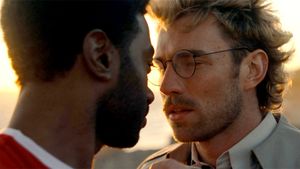Click here for updates on this story
TORONTO (CTV Network) -- Our current projections for fighting climate change are based on the greenhouse gas sources that we already know about — but we could be dangerously underestimating, according to a new study looking at a greenhouse gas source that has, up until this point, been hidden under ice.
Researchers have found that as glaciers shrink, they’re exposing more and more bubbling groundwater springs, releasing an unknown amount of the potent greenhouse gas methane into the atmosphere.
“These springs are a considerable, and potentially growing, source of methane emissions — one that has been missing from our estimations of the global methane budget until now,” Gabrielle Kleber, lead author of the research with the University of Cambridge’s Department of Earth Sciences, said in a press release.
Kleber and her team have been monitoring the water chemistry of more than a hundred hot springs across Norway’s Svalbard Islands for the past three years, a region which is warming around two degrees faster than the average rate for the Arctic. They observed that as glaciers retreat, revealing groundwater springs, those springs are emitting huge amounts of methane. These emissions could exceed 2,000 tons annually.
Scientists have been concerned about greenhouse gases that could be revealed in the Arctic by warming temperatures for a long time, but previous research has largely focused on the emissions that result from permafrost melting. This study enabled researchers to focus on specifically the impact of glaciers melting.
“While the focus is often on permafrost, this new finding tells us that there are other pathways for methane emissions which could be even more significant in the global methane budget,” Alexandra Turchyn, a professor with Cambridge’s Department of Earth Sciences and study co-author, said in the release.
The amount of emissions the study predicts glaciers could cause over the course of a year is equal to 10 per cent of the methane emissions from Norway’s annual oil and gas energy industry, the release stated.
“Until this work was conducted, we didn’t understand the source and pathways of this gas because we were reading about studies from completely different parts of the Arctic where glaciers are absent,” Andrew Hodson, a professor with the University Centre in Svalbard and study co-author, said in the release.
Svalbard is the canary in the coal mine of glacier and climate change research, authors say.
“Living in Svalbard exposes you to the front-line of Arctic climate change,” Hodson said. “I can’t think of anything more stark than the sight of methane outgassing in the immediate fore field of a retreating glacier.”
The springs in question are fed by “a plumbing system hidden beneath most glaciers” the release explained. When glaciers retreat as they melt, they reveal these groundwater reserves to the air. Researchers searched for these new groundwater springs by picking them out from satellite images, identifying them as threads of blue on the top of ice.
Kleber would then drive out to the springs on a snowmobile to take samples of the water wherever there was evidence that the ice was blistering due to built up gas from the spring underneath the fresh layer of ice. Their analysis showed high concentrations of dissolved methane.
“In Svalbard we are beginning to understand the complex and cascading feedbacks triggered by glacier melt — it seems likely that there are more outcomes like this which we have yet to uncover,” said Kleber. This is just the tip of the iceberg, researchers say — quite literally.
“The amount of methane leaking from the springs we measured will likely be dwarfed by the total volume of trapped gas lying below these glaciers, waiting to escape,” Hodson said. “That means we urgently need to establish the risk of a sudden increase in methane leakage, because glaciers will only continue to retreat whilst we struggle to curb climate change.”
The-CNN-Wire
™ & © 2023 Cable News Network, Inc., a Warner Bros. Discovery Company. All rights reserved.


















































